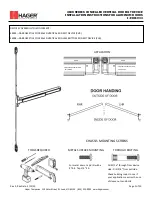
10
IMPORTANT POINTS FOR THE CARPET FITTER:
Please ensure that compatible carpet cushion and carpet are being fi tted.
Remember that you are laying carpet over a thin electrical heating element.
Extra care must be taken when working with sharp tools to avoid damage
to the Environ II panel, which could cause it to malfunction and fail.
Ensure all cables have been channelled correctly into the carpet cushion
to avoid unsightly lumps or an uneven carpet surface.
Do not install nails, screws or staples in direct contact with the ENVIRON II
heating panels and power supply cable. A staple left protruding can destroy
the ENVIRON II heater cable.
When making a join (or “seam”) in the carpet, ensure that the seaming
iron DOES NOT come into direct contact with the Environ II panel, as it
will damage the panel. Wherever possible, avoid joins in the carpet over
panels. Always use a good quality heat-bond tape, and use an ultra-wide
tape when joining heavy wool or similar carpets.
Fit your carpet as normal above the panels, taking special care when
working with sharp tools (power stretcher, knee-kicker, knives, scissors
etc) in the vicinity of the panels and cables.
Remove a small section (about 1/4” to 1/2” –wide) of the gripper at a
point on the fl oor below the thermostat and secure the cables to the fl oor
with adhesive tape, hot-melt glue or cable clips, taking care to ensure
that the cables are not damaged by the nails of the gripper.
Ensure the positioning of your Environ II panel (and the way you have
routed the cables on the fl oor from the panel to the control point) allows
suffi cient cable length to reach the connection point for the electrician
to make the connections.
Place Thermostat Warning Sticker to underside of thermostat’s faceplate.
Stickers are supplied with the Environ II mats.
Note that the power supply cables of Environ II
panels are matched to
the rated power of the panel. If more than one panel is connected to a
thermostat, ensure that the circuit connecting the thermostat to the house
power is correctly rated for the total amperage of the combined heaters.
For the total amperage of your installation look to your custom design
layout or your price quote. Overloaded power circuits may overheat and
could start a fi re!
NEVER JOIN THE POWER SUPPLY CABLES UNDER THE CARPET.
NO SERIAL CONNECTIONS OF ONE PANEL TO ANOTHER PANEL. NO
DAISY-CHAINS!
A QUALIFIED ELECTRICIAN MUST CONNECT THE POWER SUPPLY
CABLES TO THE THERMOSTAT, AND CONNECT THE THERMOSTAT
TO THE SUPPLY.
Take the cables along the edge of the carpet cushion, between the
gripper and the carpet cushion to a point directly below where the
thermostat will be fi tted (or below the socket outlet if no thermostat is
being fi tted).
Before fi tting the carpet, test the panels to ensure they are working
correctly.
A simple test is a visual inspection to make sure there is no
visible damage to the heater, and in particular to the cable component in
the heater. A simple electrical inspection can be done with an ohms meter
to make sure the ohms resistance is what it should be (see page 4). Ohms
resistance can vary signifi cantly depending on the ambient temperature
and an allowance of +/- 15% from the norm is acceptable.
Verify that the
voltage of the panels matches the voltage specifi ed on the plan.
Connect the sensor wire to the designated screws on the terminal block
on the front of the thermostat power base. The wire must pass outside the
electrical box and follow the wall down to the fl oor. This is a low voltage
wire and in most geographical areas it does not need to be housed in a
conduit. If you choose to place it in a conduit, use a separate conduit
than the conduit used for the 110-volt or 220-volt wires that power the
heating element.
Secure the power supply cables (and the thermostat sensor cable, where
applicable) in the channel in the carpet cushion with adhesive tape, to
prevent them from “riding up” onto the top surface of the carpet cushion
and thus causing unsightly lumps or ridges when the carpet is fi tted.


































